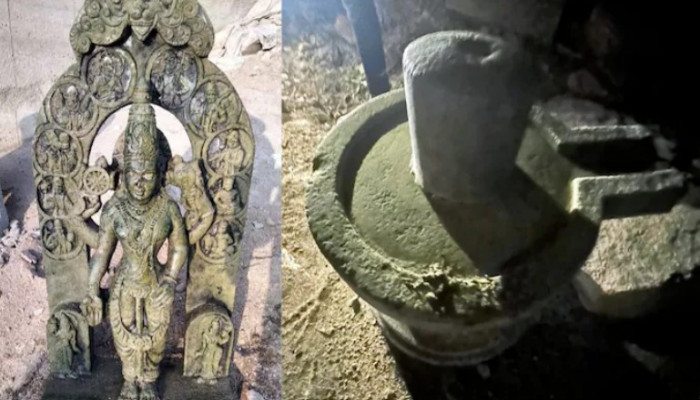Centuries-old vigraha of Vishnu and Shivling found in Krishna River near Raichur
- In Reports
- 05:20 PM, Feb 07, 2024
- Myind Staff
Officials have reported the recovery of a centuries-old vigraha of Bhagwan Vishnu and a Shivling from the Krishna riverbed near the Telangana-Karnataka border. The discovery occurred during the construction of a bridge in Raichur, Karnataka.
Archaeological experts speculate that these artifacts could potentially date back as far as 1,000 years. Following their retrieval, both the Vishnu vigraha and the Shivling have been transferred into the custody of the ASI.
Eyewitnesses have disclosed that the discovered vigraha, which include the Dashavatar of Lord Krishna and a Shivling, bear striking similarities to the recently consecrated idol of Ram Lalla in the Ram Mandir in Ayodhya.
While discussing the Vishnu vigraha found in the Krishna river basin, Dr. Padmaja Desai, a lecturer in ancient history and archaeology at Raichur University, speculated that the idol likely adorned the sanctum sanctorum of a temple before being deposited into the river, possibly during a period of temple destruction.
Dr. Desai further elaborated on the special features of the Vishnu idol, noting the presence of an aura surrounding Vishnu depicting the 'dashavatara,' including Matsya, Koorma, Varaha, Narasimha, Vamana, Rama, Parashurama, Krishna, Buddha, and Kalki.
She elaborated on the features of the vigraha, explaining that Vishnu stands with four arms. In the statue, the two upper hands hold the 'shankha' and 'chakra,' while the two lower hands are positioned to grant boons.
The lecturer noted that the vigraha bears a resemblance to Bhagwan Venkateshwara as described in the scriptures. However, she observed that unlike typical Vishnu vigrahas, this one lacks the presence of Garuda, instead featuring two fan-bearing women.
She explained that the vigraha likely adorned the sanctum sanctorum of a temple and remains mostly intact, except for some damage to its nose. Dr. Desai suggested that the idol may have been submerged in water to protect it from damage during an attack on the temple.
Dr. Desai highlighted that Bhagwan Vishnu, known for his fondness for decoration, is depicted smiling and adorned with garlands and ornaments in this particular idol. Archaeologists believe that the idol belonged to the 11th or 12th Century CE.
Image source: India Today







Comments